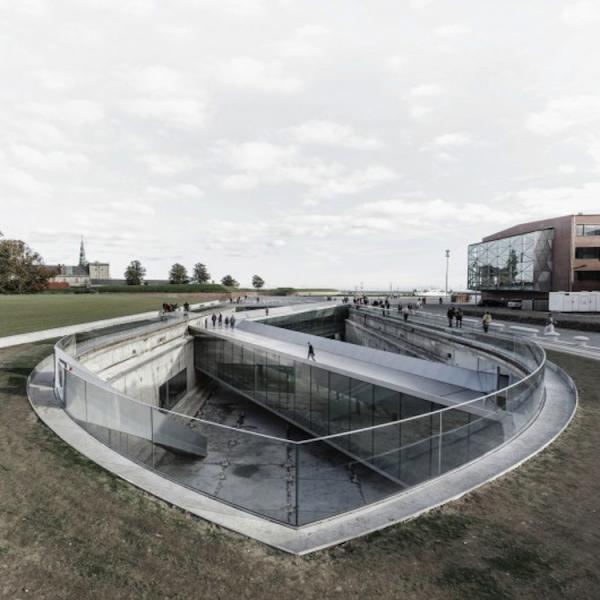The five finalists for the 2015 European Union Prize for Contemporary Architecture, or the Mies van der Rohe award. The finalists were chosen from a shortlist of 40 projects and include a sunken museum and a crystalline concert hall.
Considered to be some of the best works completed by European architects in the previous two years, the projects are in the running for a prize of more than $65,000.
The five finalists for the Mies van der Rohe award are:
- Philharmonic Hall Szczecin designed by Estudio Barozzi Veiga in Szczecin, Poland
- The Saw Swee Hock Student Centre by O'Donnell + Tuomey at the London School of Economics in London
- Ravensburg Art Museum designed by Lederer Ragnarsdóttir Oei in Ravensburg, Germany
- Danish Maritime Museum designed by Bjarke Ingels Group in Helsingør, Denmark
- Antinori Winter by Archea Associati in San Casciano Val di Pesa, Florence, Italy
The architects will present their projects to the jury on May 7.
 Philharmonic Hall Szczecin designed by Estudio Barozzi Veiga in Szczecin, Poland. Photo by Simon Menges
Philharmonic Hall Szczecin designed by Estudio Barozzi Veiga in Szczecin, Poland. Photo by Simon Menges
 The Saw Swee Hock Student Centre by O'Donnell + Tuomey at the London School of Economics in London. Photo by Alex Bland
The Saw Swee Hock Student Centre by O'Donnell + Tuomey at the London School of Economics in London. Photo by Alex Bland
 Ravensburg Art Museum designed by Lederer Ragnarsdóttir Oei in Ravensburg, Germany. Photo by Roland Halbe
Ravensburg Art Museum designed by Lederer Ragnarsdóttir Oei in Ravensburg, Germany. Photo by Roland Halbe
 Danish Maritime Museum desinged by Bjarke Ingels Group in Helsingør, Denmark. Photo by Rasmus Hjortshoj
Danish Maritime Museum desinged by Bjarke Ingels Group in Helsingør, Denmark. Photo by Rasmus Hjortshoj
 Antinori Winter by Archea Associati in San Casciano Val di Pesa, Florence, Italy. Photo by Pietro Savorelli
Antinori Winter by Archea Associati in San Casciano Val di Pesa, Florence, Italy. Photo by Pietro Savorelli
Related Stories
Laboratories | Apr 13, 2017
How to design transformative scientific spaces? Put people first
While most labs are designed to achieve that basic functionality, a transformational lab environment prioritizes a science organization’s most valuable assets: its people.
Hotel Facilities | Apr 12, 2017
Hotels embrace place
Today’s hospitality environments emphasize unique, localized experiences to attract and engage guests.
Green | Apr 11, 2017
Passivhaus for high-rises? Research demonstrates viability of the stringent standards for tall residential buildings
A new study conducted by FXFOWLE shows that Building Teams can meet stringent Passivhaus performance standards with minimal impact to first cost and aesthetics.
Curtain Wall | Apr 11, 2017
Masters of geometry
Three firms that specialize in façades that curve, twist, and turn see themselves as artisans of the unthinkable.
Office Buildings | Apr 10, 2017
Innovation lab makes developing eye care solutions a collaborative affair
The Shop East innovation lab presents 13,500 sf of workspace across two floors with an emphasis on collaboration.
Architects | Apr 10, 2017
New Bjarke Ingels documentary gives a peek behind the curtain
The movie takes a slightly darker tone than previous projects chronicling the starchitect’s rise to prominence.
Architects | Apr 4, 2017
Architect Howard Elkus dies at 78
Cofounder of Elkus Manfredi Architects, his career spanned five decades, and included a spectrum of major design projects.
Building Team | Apr 4, 2017
Dispelling five myths about post-occupancy evaluations
Many assume that post-occupancy (POE) is a clearly-defined term and concept, but the meaning of POE in practice remains wildly inconsistent.
Structural Materials | Apr 3, 2017
Best of structural steel construction: 4WTC, Fulton Center, Pterodactyl win AISC IDEAS2 Awards
The annual awards program, sponsored by the American Institute of Steel Construction, honors the best in structural steel design and construction.
















